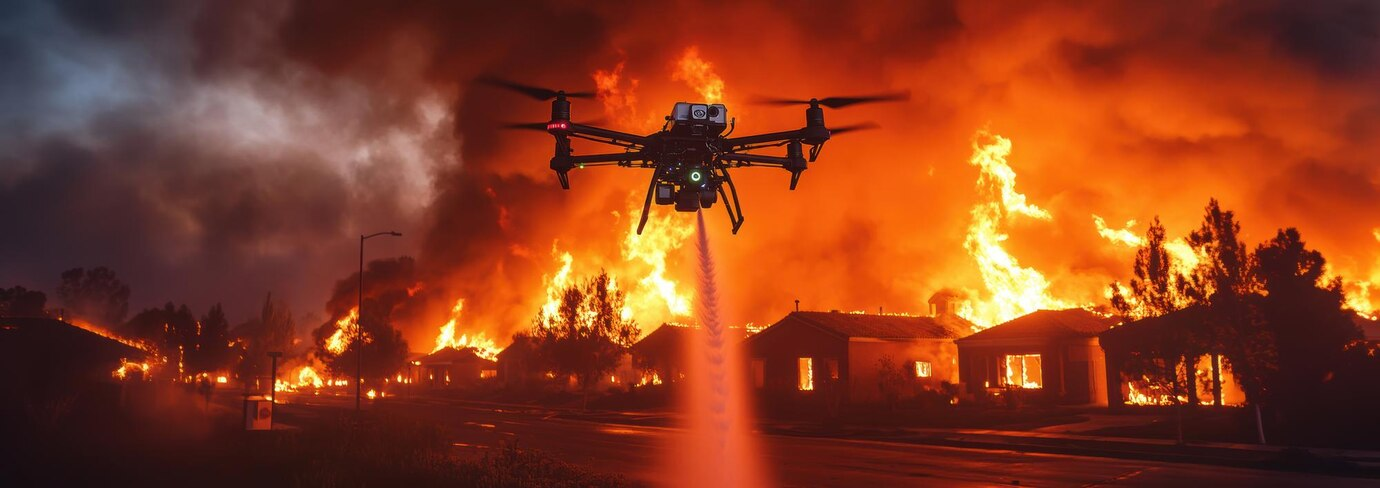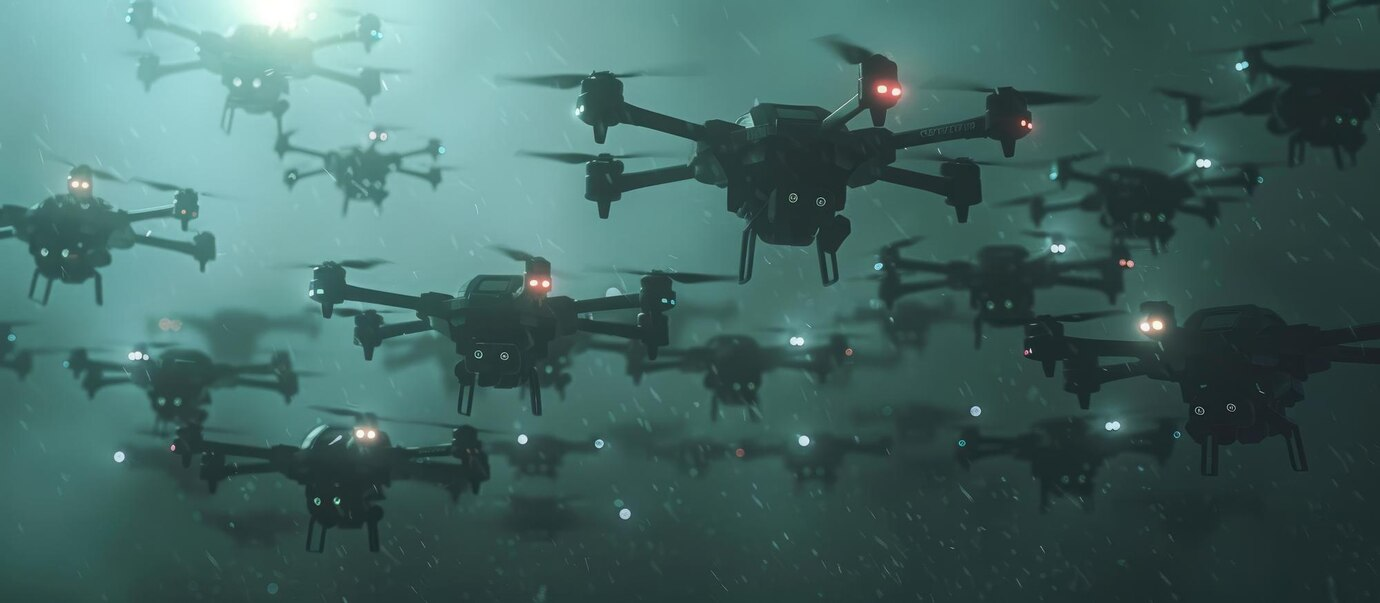Drone Swarms for Disaster Response
Disasters strike quickly. Buildings collapse when earthquakes strike, cities drown in floods, and fire spreads mercilessly. Human response teams contend with chaos, would-be cleared roads, and missing individuals during such times. Then comes the swarms of drones-hundreds of coordinated UAVs acting together like a digital rescue squad. Entering danger zones immediately, these intelligent machines scan for survivors and assess damage while delivering supplies. They don’t get tired, they don’t hesitate, and they don’t need clear roads. With AI-powered coordination, they will form a synchronized fleet that can cover huge areas in minutes. Governments, emergency services, and relief organizations are fast adopting this technology.
How Drone Swarms Improve Disaster Response
Speed is everything in disasters. Getting saved within 72 hours—that’s when most lives can be rescued. However, traditional rescue efforts are often delayed by collapsed roads, unsafe buildings, or flooded areas. Innovations like Melbet download demonstrate how technology can enhance real-time responsiveness, like drone swarms in disaster scenarios. These drones take off immediately, scan an area for live data at a disaster site, and send that information back to operations for rescue teams—no waiting for helicopters. No risking human lives in unstable environments. Just instant action.
It is not only speed, however. It is a complete 360 view of the site where a disaster occurred. Every collapsed structure, flooded street, or fire zone has been mapped, pinpointed, and identified. The AI then processes the information as it streams in, identifying survivors and safe havens and predicting potential structural collapses. No longer trial-by-error guessing at what direction rescuers should go-just real, data-backed answers: fewer wasted minutes, fewer missed victims, and better progress toward saving lives.
Rapid Deployment in Emergencies
All of these things point to rapid deployment in emergencies. When disaster hits, time is the enemy. Rescue efforts must start quickly; those first few minutes often determine the difference between life and death. Here is what they excel at:
- Immediate Takeoff: Covering massive areas fast rather than needing to mobilize as helicopters or rescue teams would require.
- Real-Time Data Streaming: Helping rescuers make split-second decisions through live video, thermal images, and environment readings.
- Autonomous Coordination: Free up, automatic, AI-directed drones large, spread from their own with no humans and no micromanagement.
So, teams get a comprehensive picture of the disaster before being deployed to dangerous areas. This results in faster rescues, more intelligent decisions, and more lives saved.
Core Technologies Powering Drone Swarms
There is some state-of-the-art technology-cutting-edge technology behind any great drone swarm. These are not just competent flying machines but intelligent, autonomous minds. The secret to this performance is in AI, advanced sensors, and, particularly, real-time data processing. Drone swarms would be heaps of machines without it: just a chaotic cluster.
Every second counts in disaster zones; with such technologies, a drone could negotiate a path through rubble, find a possible survivor, and even foretell a structural collapse before it happens. AI coordination prevents collision, and high-resolution sensors capture life-sensitive data. The future? No. This is already happening as governments and organizations worldwide incorporate drone swarms into emergency response plans.
AI and Autonomous Coordination
The brains behind the whole group are AI, which lets the drones communicate, share their tasks and adjust on short notice to condition changes. This works into real-time decision-making without an operator’s input, not remote control chaos.
In an earthquake zone, for example, there’d be a drone network wherein AI designates its task assignment for each of them: some search for survivors, others may assess structural integrity, and a few map safe routes for rescuers. These give their assignments without human pilots giving them step-by-step instructions. Instead, machine learning algorithms analyze the disaster scene, prioritize the most urgent areas, and adjust their swarm based on the new data. The result? Faster rescues, fewer errors, and zero hesitation. AI makes drone swarms not only practical but indispensable.
Advanced Sensors and Imaging Systems
Smoke, debris, darkness-pretty all render human visibility nearly impossible. This is precisely why there are advanced sensors for drones. They do not just “look”-they analyze, detect, and report critical data in real-time.
Key technologies powering drone swarm vision:
- Thermal Imaging: in total darkness, even heat signatures from survivors lying under rubble can be detected.
- LiDAR Scanning: helps map disaster areas with centimeter-level accuracy by identifying unstable structures and debris hazards.
- Gas and Chemical Sensors: find leaks, detect toxic fumes, or determine fire risks – all for the safety of rescue teams.
They make drones more than flying cameras; they transform them into digital scouts. Such scouts whoop their way through environments too hazardous for humans to fly. They no longer need to guess where their rescue work is required. Instead, they know where to go and which angle to take.
Search and Rescue Capabilities
The disasters have turned into the world’s most horrifying sites, where every building stands atop buildings, and everything looks like so much debris. All this makes traditional search teams sorely mistaken. Drones don’t. They have no trouble flying over obstacles and can scan huge areas instantly while pinpointing trapped survivors in real-time. Already, this changes things – wasting time or blind searches becomes obsolete. The AI processes the data and commands rescue teams to precise locations.
| Capability | How It Saves Lives |
|---|---|
| Thermal Imaging | Detects body heat under rubble, even in total darkness. |
| Acoustic Sensors | Picks up faint cries for help or trapped survivor movements. |
| AI-Driven Mapping | Creates real-time escape routes for survivors and rescue teams. |
| Automated Swarming | Multiple drones work together, covering massive disaster areas. |
With such instruments, drone swarms locate survivors much faster than a human team could. Every second counts, and such drones ensure no one goes to waste.
Structural Damage Assessment
The aftermath of disasters produces dangerous wreckage, including collapsed bridges, unstable buildings and flooded roads that make damage evaluation difficult. Drones take such risks. Drone-operated LiDAR and thermal imaging systems fly above unstable structures to identify structural weaknesses before collapse through aerial data collection.
The collected data immediately leads to creation and innovation, producing 3D safety mapping to identify safe travel paths and critical danger locations. Emergency teams and governments receive exact real-time evaluations that eliminate the need to guess their starting point. Response times decrease during rescue missions, while secondary disasters, such as trapped responders, are prevented through these assessments.
Medical and Supply Deliveries
When a road is blocked, and a helicopter cannot land, how do you get medical assistance to the injured? Drone swarms assure fast, targeted delivery without risk to human lives. Countries already use drones to deliver blood in emergencies, proving their effectiveness in working in actual crises.
Drones also do not carry goods. They are adaptive. AI guarantees their navigation through complicated terrain, dodging debris and readjusting flight paths in real-time. Some even drop inflatable rafts for flood zones or attach small defibrillators for cardiac emergencies. Where traditional transport fails, drones will step in.
Challenges and Future Potential
There is no perfect technology – weather elements, battery limits, and the seamless AI coordination of drone swarms also challenges. The pace of innovation, however, is breakneck. Recently developed drones are weather-resistant, solar charging has been extended to increase flight time, and AI’s energy use toward much more efficient swarm performance is always underway.
The future? Complete autonomy: fully AI-driven disaster response. Imagine swarms of drones deploying as soon as the second disaster strikes, coordinating search, rescue, and medical aid-waiting for no human delays. They will become first responders.


